Implementation 2 – Data Collection
This training chapter shows, which options for data collection with Mapp Intelligence exist and what advanced setup possibilities arise.
1 Options for data collection
There are various ways to track web analytics data in Mapp Intelligence.
Website
- Tag Integration
- Standard pixel
- AMP extension
- Server-to-Server communication
Apps
- Mobile SDKs
- Server-to-Server communication
1.1 Tag Integration
Mapp-specific product features, tags of other service providers, and custom plugins can be configured in a straightforward user interface with Tag Integration.

All tags are aggregated in one JavaScript.
The Tag Integration script is loaded asynchronously. Thus, it does not slow down the loading of the website.
The specific tags work like as if they would have been integrated without Tag Integration.
Some tags of external service providers generate cookies. In these cases, opt-out possibilities have to be integrated for each tag.

In order to track users with deactivated JavaScript include an additional NoScript pixel int the website.
For an easier integration of Intelligence, Mapp provides extensions for some CMS and shop systems. Find a list of available extensions here.
Special features of Tag Integration:
- Low demand on the resources of the IT department for maintenance and the expansion of data collection.
- Independent of internal release processes.
- Data sovereignty: You decide, which data you send to external tag providers.
- Efficient data collection with the use of a uniform data layer.
- Future-proof: Ongoing expansion of the plugin library by Mapp.
- Initial setup for the configuration of Tag Integration necessary.
Containers
A container defines an URL section.
For each Mapp Intelligence account (e.g. live account, test account) a container has to exist.
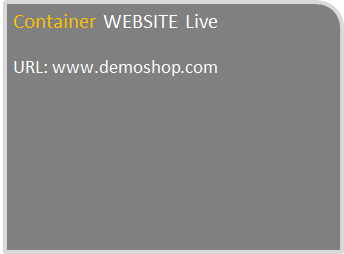
Plugins
For each container, a defined set of plugins is used.
Plugins can be configured individually for each container.
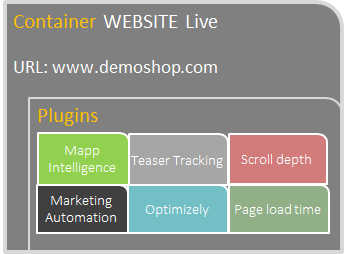
Available plugins for Mapp-specific product features and other service providers:
Find a list of all available plugins here.
Custom Plugins
Custom plugins can be created (Custom plugins > New custom plugin). They can be executed in different positions as well:
- Instantly
As soon as Tag Integration has been fully loaded.
e.g. A/B tests - In Head
Before the website content is loaded.
e.g. jQuery frameworks - After <BODY>
When the website content starts loading.
e.g. marketing pixel on the order
confirmation page - Before </BODY>
When the website content has been fully loaded.
e.g. 3rd-party tracking provider

Parameters
Parameters are information, that has to be defined globally in Tag Integration. They can be used in plugins (e.g. page name, order ID).
For doing so, JavaScript variables or URL parameters can be used.
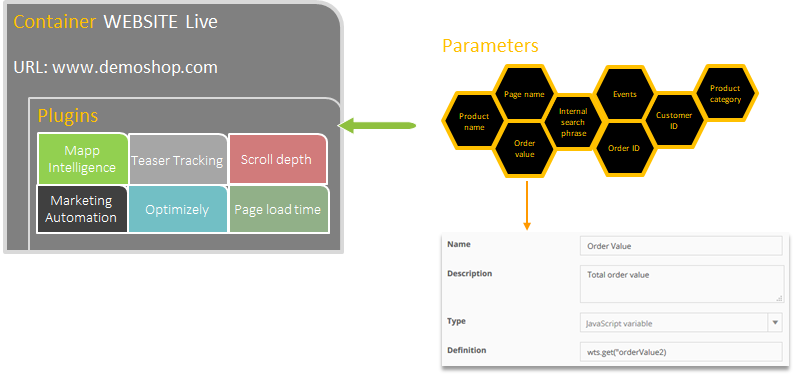
Mapp recommends using a global data layer, which provides all relevant information.
This information is requested and defined as parameters in Tag Integration.

Please click here to get more information on data layers.
Rules
Rules are used to define when plugins should be executed.
Parameters, events or the URL can be used for definition.
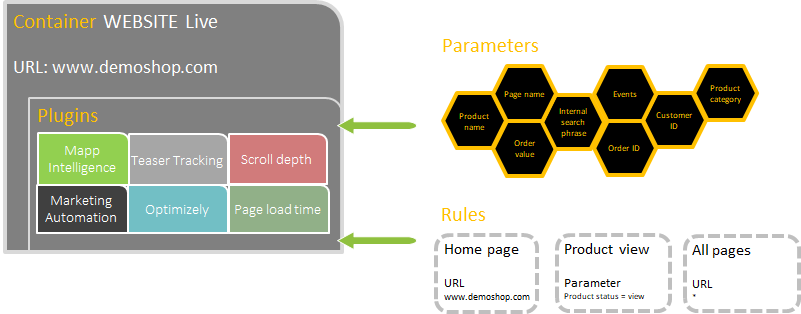
By using a filter function, various conditions can be combined with each other.
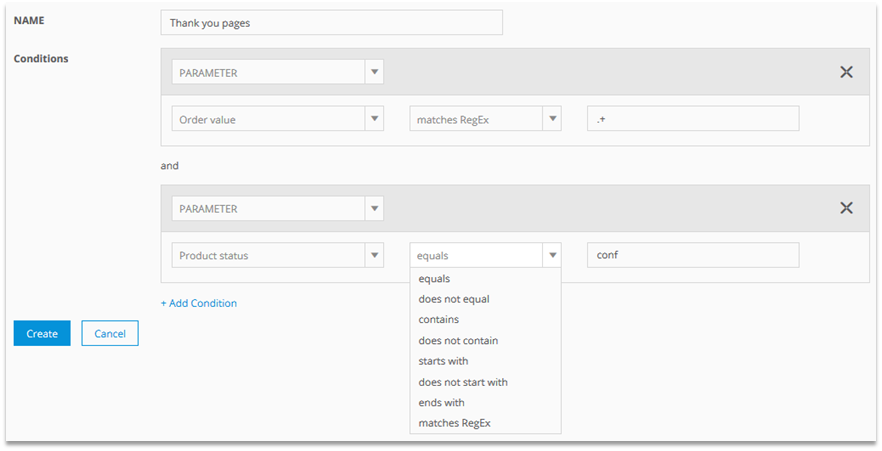
1.2 Standard pixel
Data collection can also be done via a standard pixel.
- The pixel is integrated in the source code of the website.
- Each page (also e.g. layers) should contain a pixel in order to prevent errors in the data interpretation.
- Users with and without activated JavaScript can be tracked.
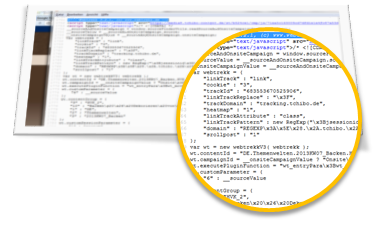
For a quick and easy integration, Mapp provides plugins for some shop systems (e.g. Hybris, Magento 2, Shopware).
The following steps happen when a website is requested:
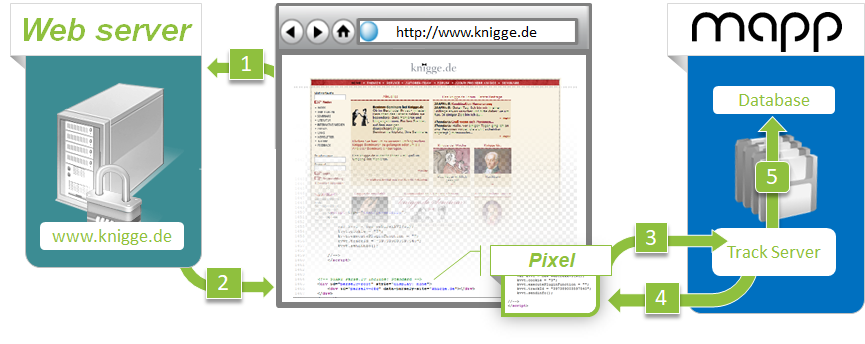
Special features of the standard pixel:
- Compared to Tag Integration there is a higher effort in the IT department for maintaining and extending the data collection.
- Often adaptions are lengthy, as they depend on internal release processes.
The chosen integration position has a significant influence on the data collection
- When integrating it at the beginning of a website: Tracking is done as quickly as possible.
- Advantage: Higher data accuracy.
- Disadvantage: Qualitative view only available when using additional plugins (e.g. scroll depth, page load time).
- When integrating it at the end of a website: Tracking is only done, when the page was loaded completely.
- Advantage: Qualitative tracking.
- Disadvantage: Missing data (e.g. campaigns, orders).
1.3 Accelerated Mobile Pages - AMP
AMP is an open-source project and serves for accelerating mobile websites. Depending on the device either the "normal" website is displayed or the AMP website.
- Mapp Intelligence can be used via the "amp-analytics" extension.
- A limited range of functions is supported.
The tracking of media, forms, and heatmap is not possible. - Pixelation (e.g. page naming) has to be done manually.
1.4 Mobile SDKs
For a quick app integration, Mapp provides SDKs for Android and iOS.
- The range of functions for the tracking is the same as with pixel integration.
- Tracking data for offline usage is stored temporally and sent as soon as an internet connection is available again.
- Automatic tracking of activities.
- No app store release for adaptions of the tracking necessary, when using the mobile container in Tag Integration.
Special features of the mobile SDKs:
- Quick setup process.
- Supports only the native developer tools.
The following steps are executed when the app is used:

1.5 Server-to-Server
Data is transmitted directly from the web server and not from the client to Mapp.
Example:
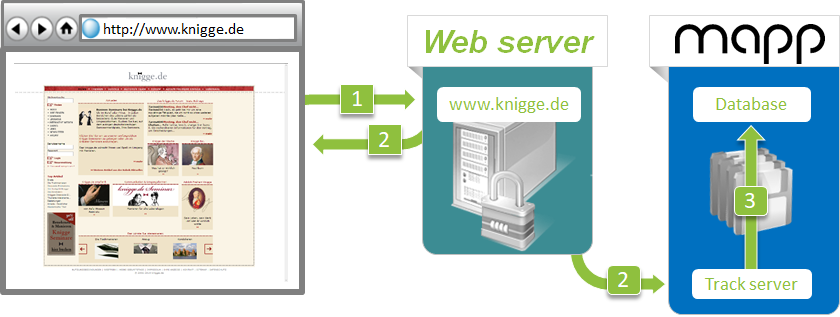
The process is also used to measure directly linked PDF files.
Special features of Server-to-Server:
- Very high data accuracy.
- No tracking visible.
- Consider data privacy (opt-out possibility).
- Complex integration.
- No direct testing on the website possible.
Structure of a tracking request:
http[s]://[track domain]/[track ID]/wt?p=[version] ,[page name],…
Further information can be found in the technical documentation.
2 Advanced setup
The advanced setup takes the following points into account:
- First-/third-party cookies
- Custom domains for data collection and Tag Integration
- How many accounts?
- Access exclusion
- Data privacy
- Single page applications
- Multitab browsing
2.1 First-/Third-party cookies
First- or third-party cookies can be used to recognize visitors with Tag Integration or the standard pixel.
First-party cookies
- The cookie is set in the domain of the website.
- Greater acceptance enables higher data accuracy.
- Default setting in Mapp.
Third-party cookies
- Cookie is set in the track domain.
- Domain-independent tracking in an account WITHOUT session break.
- Is deleted automatically by some browsers after session end.
| To improve the visitor identification, a customer ID should be submitted. |
|---|
2.2 Custom domains for data collection and Tag Integration
Track domain: Where should the tracked data be sent to?
- Mapp track domain
The data is sent directly to a Mapp domain (e.g. "knigge.wt-eu02.net").
Advantage: Domain-independent visitor recognition possible (when using third-party cookies).
Disadvantage: No measurement when tracking blockers are used. - Custom track domain
A custom sub domain (e.g. "img.knigge.de") is used for data submission.
A redirection is done from there to the Mapp track domain.
If SSL is used on the website, too, a corresponding certificate has to be installed.
Advantage: Greater data accuracy, as tracking blockers do not work.
Disadvantage: Costs for certificate (when using SSL).
Tag Integration: From where is Tag Integration loaded?
Mapp domain
"responder.wt-safetag.com" is requested.Custom domain
Alternatively, custom domains can be used, that redirects to the Mapp domain.If SSL is used on the website, too, a corresponding certificate has to be installed.
Advantage: Greater data accuracy, as tracking blockers do not work.
Disadvantage: Costs for the certificate (when using SSL).
Example of custom domains used for data collection and Tag Integration:
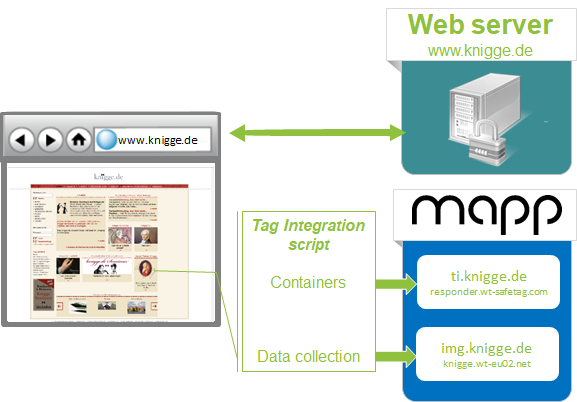
In order to ensure a best possible data accuracy, custom domains should be used for tracking and Tag Integration.
2.3 How many accounts?
Is all data supposed to be tracked in one account?
Example for useful differentiation:
- Different countries (e.g. Shop UK, Shop US)
- If pages of different content are tracked (e.g. shop and blog)
- Live/test account
Usually, one live and one test account are recommended. Thus, tests won’t impact data analysis!
Benefits and disadvantages of separate accounts per country:
Benefits | Disadvantages |
|---|---|
No filtering on domain/country/page etc. required. | Account setup more complex. |
Less data leads to faster calculation. | Usually higher costs. |
Customized naming of metrics, parameters etc. possible (e.g. in local language). | No overview of total accesses (Please note: Cross-domain visitor recognition for first-party cookies only with customized implementation possible!) |
Limits (e.g. reports amount, parameter characteristics) apply for each account. | |
Better account administration for individual teams. | |
Less custom metrics required (e.g. “Visits US”, “Visits UK”…) | |
Campaign structure properly displayable. |
Most flexible solution: Use an overall account and additional sub accounts.
By using the feature "Dataprofile" it is possible to automatically copy tracking data into other accounts. Thus, various accounts can be filled by one pixel.
Example:
Data collection in one overall account ("Shop Global"), in which overall analyses are possible. For individual shop analyses separate local accounts ("Shop UK", "Shop US") are used.
- Copy from sub accounts to a global account
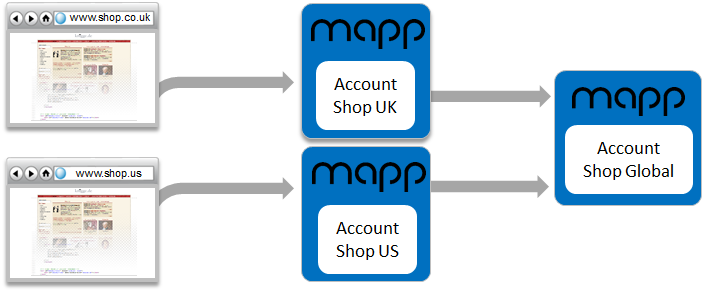
- Copy from global account into sub accounts

Configuration is done at Mapp Q3 > Configuration > System configuration > Data collection.
Please note that the source and target accounts should be configured identically (e.g. custom parameters, categories…).
Configuration examples:
- If the parameter cg1 ("content group 1") is set for the value "uk", the track request is copied from the account "Shop UK".

- If the domain is "mobile.shop", the track request is copied from the account "Mobile Shop".

Filters can be set using regular expressions.
2.4 Exclusion of access
Known bots and crawlers are automatically excluded from the measurement.
Moreover, access can be excluded on the basis of the following criteria:
- IP address
- Domain
This might be useful in order to prevent the own access activity or that of an agency from distorting the data.
The setting can be found under Mapp Q3 > Configuration > System Configuration.
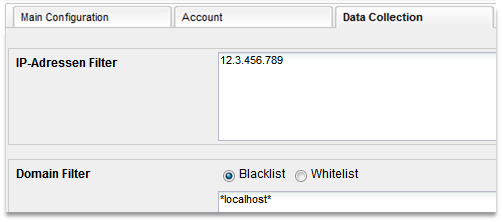
2.5 Single page applications
For single page applications data is submitted by a function call.
In the call it is determined, if the tracking should be done as event or page. By doing so, virtual pages can be generated.
Please note, that the use of virtual pages is suitable for various calculations:
- Page duration
- Click paths analysis
- Process/funnel analysis
- Entries/exits/bounces
2.6 Multitab Browsing
Mapp offers two different options of how data can be collected when using multiple browser tabs.
Variant A
As soon as a new tab is opened (even if the active tab is not left), Mapp tracks it. Renewed accesses of a tab are not counted a second time.
Advantages:
In some circumstances, it can be more cost-effective, because fewer page impressions are measured. Correlates with common measurements in the analytics tool.
Variant B

Only when a tab is seen, Mapp tracks it. Every renewed call of a tab leads to a repeated count.
Advantages:
Corresponds to the real user behavior. (Page) paths are correctly depicted. Clicks (events) are correctly assigned to a page.
Additionally to the settings mentioned above, multitab browsing needs to be activated from Mapp's side. Please contact your Customer Success Manager to check that it is activated for your account.
Example:
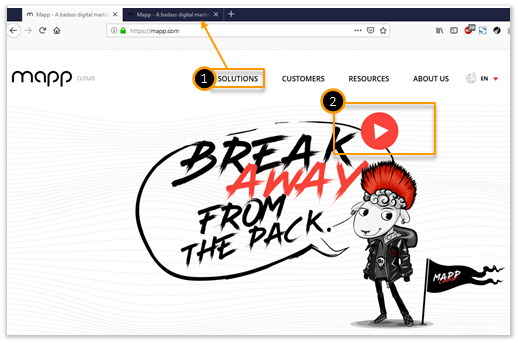
While being on the page “Home”, the link for “Solutions” is opened in another tab (not seen!). Afterward, the video link is clicked, following a switch to the tab “Solutions”.
A) As soon as a tab is opened, Mapp Intelligence tracks it.
B) Only when a tab is seen, Mapp Intelligence tracks it.
